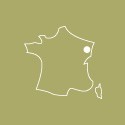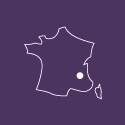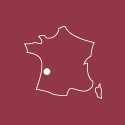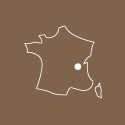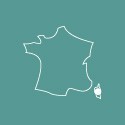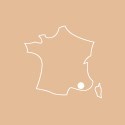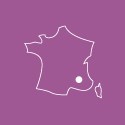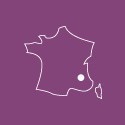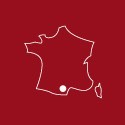Vins Privés
Our Partner Wine Estates by region There are no products in this category.
Subcategories
Alsace
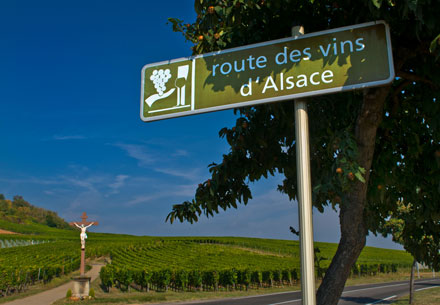
See the latest sales in this region
The vineyards of Alsace (15,000 hectares) stretch for 170 km, from Strasbourg in the North to Mulhouse in the South, along a narrow band barely more than a few kilometres in width.
Nestled in the shelter of the massif formed by the Vosges, which provides an obstacle to the bands of rain sweeping in from the Atlantic Ocean, the Alsace region has surprising low rainfall and the hours of sunshine are unusually high for this latitude. With East/South-East exposure, the grapes in the area find the conditions ideal for achieving the ideal maturity.
Of note is the wide diversity of soil types that make up the region: granite, limestone, sandstone, marl, calcareous clay and son on. These varying soils enable the same grape type to find differing expressions in the wines it creates, as can be seen from the various great vintages produced.
The majority of the wines are produced from a single grape type, although some innovative winemakers have opted for blended wines in recent years that better reflect the identity of the ‘terroir’ – that wonderfully indefinable French term that means ‘soil’ or ‘land’ or even ‘micro-climate’ – and all of the individual local factors that go to create the wines.
Alsace wines are often wonderfully fresh, with a highly aromatic side to them, as well as residual sweetness sometimes. Whites make up 90% of production, with reds and rosés (based on pinot noir) 10%. The 52 ‘Grands Crus’ produce 4% of the region’s total volume of around 1,150,000 hl.
Recent vintages:
- 2011: an abundant harvest, producing pleasant, easy-to-drink wines that should be drunk young.
- 2012: a classic year, with light, delicate wines with exotic touches. Greater potential for laying down than 2011.
- 2013: a winemaker’s vintage. Note the stunning success of the pinot blanc.
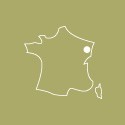
Beaujolais
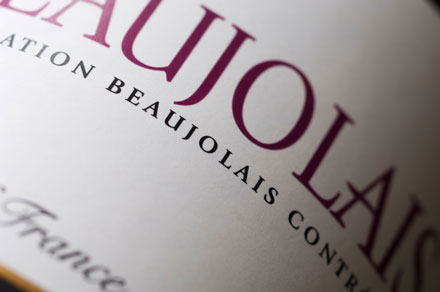
See the latest sales in this region
Officially part of Burgundy, the vineyards of Beaujolais differ both in terms of the undulating landscape and the grape type used: here, gamay is king!
The region extends for 50 km from North to South, averaging 15 km in width. There are 18,400 hectares of vineyards, producing an average of 1 million bottles annually.
The Beaujolais climate is temperate, influenced by three different components: continental, oceanic and/or mediterranean. The contrast in temperature can sometimes by extreme, depending on the prevailing winds.
The region enjoys good hours of sunshine on the best hillside locations.
Production is 99% red wine, with 10 different vineyard villages (Brouilly, Chénas, Chirouble, Côte de Brouilly, Fleurie, Juliénas, Morgon, Moulin-à-Vent, Régnié and Saint-Amour). This is in addition to the more generic Beaujolais and Beaujolais Villages and 1% of white wine (chardonnay). Altitude varies from 190 to 550 metres.
In general, Beaujolais wines are low in tannin, fresh, lively and very flavoursome. Some vintages have good potential for ageing (a decade or more for good years).
Recent vintages
- 2011: a year of great maturity with low acidity, making the wines winning and drinkable from a young age.
- 2012: a more uneven year, with the best winemakers standing out from the crowd. Some of the wines require a little time before being opened.
- 2013: a somewhat late vintage, with rich, deep wines with good cellaring potential.
- 2014: an excellent vintage of - depending on the winermaker's hand - voluptuous and fruity wines to be drunk young, or dense wines suited for cellaring.
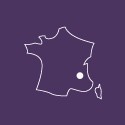
Bordeaux
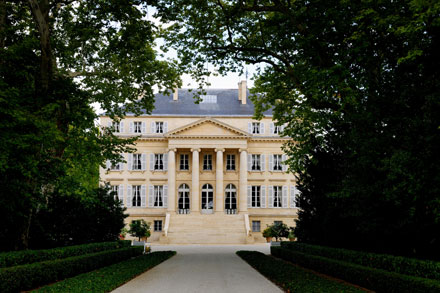
See the latest sales in this region
Wines from Bordeaux are the quintessential image of French wine around the world. The region has 117,500 hectares of vineyards and produce 5,700,000 hl of wine in an average year.
The vineyards are wrapped around the Garonne, Dordogne and their shared estuary, the Gironde.
The climate in Bordeaux is temperate, with the vineyards themselves protected from the ocean by the département of Landes. Frosts are infrequent and while the spring and summer are sometimes fairly wet, a fine autumn is often the determining factor for the quality of the vintage.
The Bordeaux subsoil tends to be rather diverse. As a result, major vintages are often grown on gravelly hilltops, while the surroundings are made up of limestone or clay sediments les. Part of the complexity of Bordeaux stems from the way the grape type and subsoil combine to work their magic.
Grape types – red: merlot (60%), cabernet sauvignon (25%), cabernet franc (11%), as well as petit verdot and malbec.
Grape types – white: semillon (53%), sauvignon (35%), muscadelle (6%), as well as colombard and ugni blanc.
Recent vintages
- 2010: rich, powerful reds with imposing tannins. Great cellaring potential. Fresh, elegant dry whites. Fine sweet wines, fruity with fine acidity
- 2011: contrasting red with imposing tannins and immediate acidity.. Good dry whites that are easy to drink and refreshing. Rich, concentrated sweet wines.
- 2012: reds better on the right bank with its dominant Merlot grape. Drink fairly young while awaiting previous vintages to mature. Fragrant, well-balanced dry whites.
- 2013: a different, varied red vintage, but fine wines to be drunk young. Very fine and aromatic dry whites. Liquorous, ideal for racking with a magnificent balance.
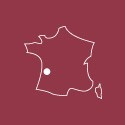
Burgundy
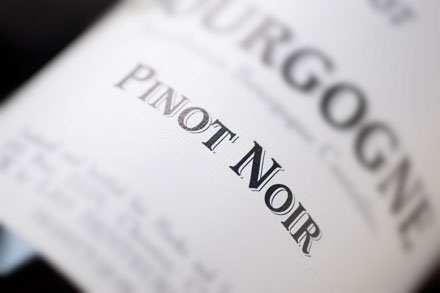
See the latest sales in this region
Although it represents just 3% of France’s vineyards (with a planted area of 27,500 hectares and production of 1,500,000 hl), Burgundy symbolises French wine around the world, along with Bordeaux and Champagne.
60% of the region’s wines are whites based on chardonnay, while 32% are reds using pinot noir grapes and 8% rosés and sparkling wines.
Its vineyards are northerly in location, with white wines that are lively but well-rounded, structured and complex, with flavours of citrus, white flowers, butter and hazelnut, sometimes with a touch of minerals or undergrowth.
As for the region’s reds, their acidity often gives them great potential for ageing. They feature notes of Morello cherries and red fruit, which gain in complexity as time passes.
Although Burgundy only has virtually two grape types, the extreme diversity of the micro-terroirs (called climates) confers an amazing diversity of nuances to the wines, depending on the soils, slope or orientation.
Vineyards tend to be very fragmented, with plots that are usually limited in size. This small scale of production essentially requires manual harvesting and can result in a whole range of different crops and wines from the same winemaker, which gives the finished product genuine personality.
Burgundy is made up of four geographical areas: Yonne (Chablis), Côte d’Or (Côte de Nuits and Côte de Beaune), Côte Chalonnaise and Maconnais.
Recent vintages
- 2010: a year that produced fresh, rich, velvety wines, very typical of Burgundy. Concentration due to small yields.
- 2011: wines that were tender and quite rich, with fine tannins. The low acidity makes them versatile.
- 2012: fine, easy-to-drink wines with good acidity. Fairly low production levels, but good quality.
- 2013: a different, varied red vintage, but fine wines to be drunk young. Very fine and aromatic dry whites. Liquorous, ideal for racking with a magnificent balance.
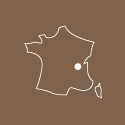
Champagne

See the latest sales in this region
The most northerly wine-growing region in France. This makes it ideal for developing sparkling wines that require a grape that is not too ripe so that the freshness of the bubbles is preserved.
The climate in Champagne is affected by two influences: oceanic and continental, which explains why the vintages lack evenness and regularity, depending on whether one or the other is in the ascendancy.
Main regions: Montagne de Reims, Côte des Blancs, Vallée de la Marne and Aube, which is detached, some 75 km to the South.
Most of the wines are sparkling, although there are also some still wines, such as Coteaux Champenois and the rare Les Riceys rosés. On average, total production is 320 million bottles.
The subsoil is mainly limestone, which has allowed hundreds of kilometres of galleries to be burrowed out, which are particularly well-suited to storing wine.
1 white grape (chardonnay) and 2 black grapes (pinot noir and pinot meunier) are used in the wines, some of which are blends, others made from a single grape type, usually chardonnay.
They are given a specific vintage when the production quality justifies it, or else the wines are made from 2 or 3 different years, which in turn add their own characteristics.
Champagne is marketed jointly by the major production houses (80% of exports) and individuals producers.
Best recent vintages: 2012 and 2008.

Corsica
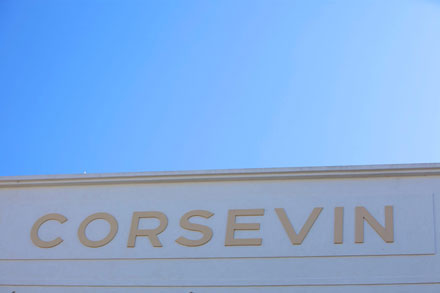
Corsica’s wine production focuses on producing wines of various types made from local grapes, with the significant development of organic growing.
An area of 7,000 hectares produces 350,000 hl of wine, made up of rosés (55%), reds (33%), dry whites (10%) and sweet whites (2%).
Today, Corsica has 9 Appellations d’Origine Contrôlée, which are classified as follows:
Two main appellations (Ajaccio and Patrimonio), five ‘village’ appellations (Calvi, Sartène, Figari, Porto-Vecchio and Coteaux du Cap Corse), one regional appellation (Vins de Corse) and one appellation for natural sweet wines (Muscat du Cap Corse).With the island’s hilly terrain, with a succession of sun-drenched hillsides, one might expect Corsican wines to be heavy and highly alcoholic. But in fact, the sea breezes cool this heat as they fan the vineyards. As a result, the wines are often fine and delicate.
Corsica has 3 types of soil: granite to the South and West, shale in the North East and limestone between the two.
Local grape types, for reds, are niellucciu, tannic and suited to limestone soils and sciaccarellu, which is fruitier. For whites, vermentinu (called rolle in Provence) dominates. They are supplemented by grape types imported from the South of France: grenache, syrah, clairette, muscat à petits grains and others.
Recent vintages
- 2011: a fresh year with plenty of acidity in the whites. Tasty light reds.
- 2012: good dry and sweet whites. Light reds.
- 2013: concentrated whites in the North and softer in the South. The reds are balanced and flattering.
- 2014: magnificent reds with a fresh ripeness and plenty of fruit. Lively whites in the North and rounder in the South.
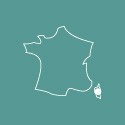
Jura
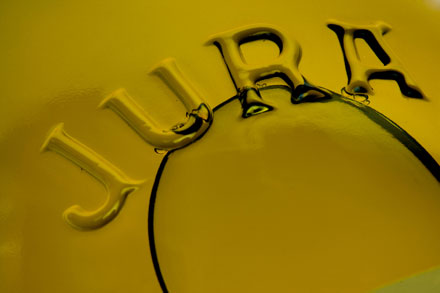
In addition to Burgundy grape types (chardonnay and pinot noir), the Jura also has its own native grapes that make its wines so individual: savagnin for whites, poulsard and trousseau for reds.
The Jura region currently has 6 Appellations d’Origine Contrôlée (Arbois, Côte du Jura, Château-Chalon, Macvin, L’Etoile, Crémant du Jura).
There are 1,850 hectares of vineyards, producing 85,000 hl of which 2/3 are whites and 1/3 reds and rosés. The region extends along the descending slopes of the Jura mountains to the plain.
The climate is definitely continental, with cold winters and unpredictable summers alternating between being mild or producing a heatwave.
The wines reveal characteristics of good quality, either as a result of the grape types used, or the method of winemaking ‘under the veil’.
Poulsard grapes produce very light-coloured wines, low in tannin but fruity. Trousseau grapes are richer in colour and tannin. Savagnin grapes are used to make the famous yellow wine, which is highly oxidised. Raised in the classic manner (‘ouillé’ to prevent oxidation), they produce great local wines that have the potential to be kept for a long time. Finally, the straw-coloured wine is sweet, with powerful flavours achieved by pressing dried bunches of grapes where the sugars are concentrated.
Recent vintages
- 2011: great year for whites, very drinkable. The reds are lighter.
- 2012: very good year for well-balanced whites. The reds are still on the way and need waiting for.
- 2013: good year for chardonnay, pinot noir and trousseau.
- 2014: delicious reds from small yields. Very accomplished whites, both in Chardonnay and Savagnin.

Languedoc
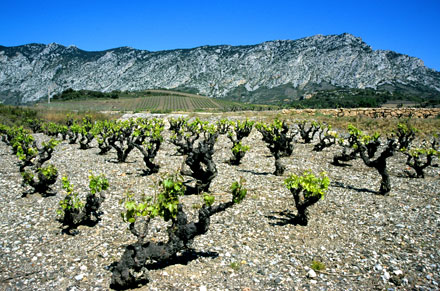
See the latest sales in this region
This is the wine-growing area that has made the greatest progress in terms of quality over the past 30 to 40 years, morphing from coarse reds into a multitude of quality wines with very distinctive characteristics. For some time now, the whites have also kept pace with the reds.
There are 245,000 hectares of vineyards, producing 1,245,000 hl of wine, mainly reds.
The region is situated between the Massif Central, the Corbières and the Mediterranean, covering a wide range of ‘terroirs’ and appellations. There’s shale, sandstone, pebbles, limestone and alluvial deposits.
The climate is very much mediterranean, with hot summers and irregular and poorly distributed rainfall.
The grape types currently planted, apart from carignan, often date from after the Second World War, in line with the subsoil. This makes for complex, exciting wines.
Reflecting this dynamism, many of the vignerons produce wines that are non-AOC (vins de pays, table wines, etc.) as they keep on searching for quality and originality.
The Languedoc has 11 AOCs, the main ones of which are Coteaux du Languedoc, Saint-Chinian, Faugères, Minervois, Minervois-la-Livinière, Fitou, Corbières, Limoux and so on.
Recent vintages
- 2011: good year for whites, which are well-balanced and fresh. The reds are more even.
- 2012: the reds are mature and fresh, with lower alcohol content. The whites are fresh and fragrant.
- 2013: the finest vintage since 1998. The reds display freshness, quality tannins and fragrant finesse. The whites blend good balance with maturity and acidity.
- 2014: fresh, tender reds to be drunk young. Tonic, aromatic and fresh whites.

Loire
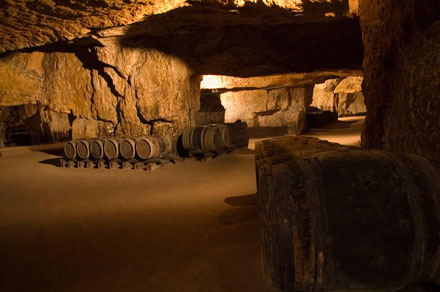
See the latest sales in this region
This majestic river links various wine-growing sub-regions that go to make up the overall appellation, from the Massif Central to the Atlantic.
The Loire region extends over almost 1000 km and there are 4 sub-regions: Nantes, Anjou, Touraine and the Centre. There are 68 Appellations d’Origine Contrôlée.
Altogether, there are 65,000 hectares producing nearly 3,0000,000 hl of wine on average each year, of which 45% are whites, 22% rosés, 21% reds and 12% sparking wines.
The areas planted with vines stretch far and wide, with a number of different climatic influences, oceanic in the West, becoming more continental the further you get from the ocean.
Three words characterise these wines: diversity, quality and affordability.
Diversity, because the whites range from the driest to the sweetest, while the reds can be fruity or mineral.
Quality, thanks to the emergence of young, talented vignerons, coupled to a significant improvement in winemaking techniques.
Affordable, because there are some amazing quality-price-pleasure ratios to be found.
The main grape types for whites are melon and gros-plant around Nantes, chenin in Anjou and western Touraine, sauvignon in eastern Touraine and in the Centre.
The principal grapes used for making reds are gamay, cabernet franc and sauvignon, pinot noir and côt (or malbec).
Recent vintages
- 2011: very good maturity for reds, well-rounded and low in acidity. Dry whites more varied, but great sweet wines.
- 2012: a varied year for weather. Few sweet wines, but highly drinkable dry whites good for cellaring, particularly Sancerre. The reds are versatile and soft.
- 2013: fruity wines, easy to drink with low alcohol content.
- 2014: a great vintage in the two colours, with aromatic wines in their youth but with good racking potential. A remarkable balance between acidity, fruitiness and concentration.

Provence
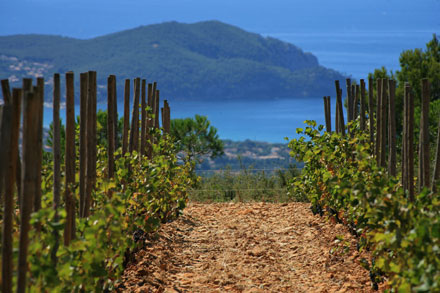
See the latest sales in this region
In this land of holidays, the reputation of Provence wines is along the same lines: easy-going rosés to be drunk sitting by the pool.
However, tourism has given new impetus to the production of wine, most of which is sold locally during the summer season.
With nearly 30,000 hectares of vineyards, the region produces 1,300,000 hl, the majority of which are rosés (40% of national production), followed by reds and the harder-to-find whites.
There are 13 Appellations d’Origine Contrôlée, with different vineyards due to the wide diversity of soils and microclimates influenced by altitude or proximity to the sea.
The rosés are delicate and fruity, while the reds are light and soft, some good for laying down, particularly in Bandol, depending on the years, while the surprising whites offer a largely unexploited potential.
The main grape types used for reds are grenache, syrah, cinsault, mourvèdre and cabernet sauvignon. For whites, there are rolle (or vermentino), ugni blanc and clairette.
Recent vintages
- 2011: quality whites and drinkable reds, with a special mention for the Bandols, which are powerful and tannic.
- 2012: a classic year for whites, which are smooth. The reds are delicious and fragrant, to be drunk for their fruit.
- 2013: exciting whites, aromatic and featuring an unusual freshness. The reds are easy and should be drunk young.
- 2014: the reds are fruity and pleasing with good racking potential. The whites should be drunk young.
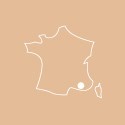
Southern Rhône
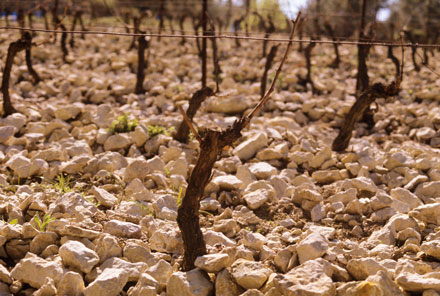
See the latest sales in this region
The Rhône Valley takes its name from the river that winds through the winemaking region over almost 200 km and is made up of two distinct parts: the northern Côtes du Rhône and southern Côtes du Rhône. The grape varieties, winemaking methods, and soil types but also the climates are relatively different. The region is the second biggest producer of AOC wine after the Bordeaux wine region.
The southern Rhône vineyards stretch from Montélimar to Avignon over the departments of the Drôme, Ardèche, Vaucluse and the Gard. They are located on both sides of the Rhône from Donzère to the confluence with the Durance, on slopes and plateaux that vary in altitude. They produce a broad range of wines, from the simplest to the most complex, but always generous. There are 15 different AOC areas, including Châteauneuf-du-Pape, Vacqueyras, Gigondas, Lirac, Tavel, Rasteau, Ventoux, Lubéron and of course all the Côtes du Rhône Villages (95 villages).
The climate is of mediterranean type and very dry, marked by the Mistral wind. This climate is however slightly different and wetter for the vineyards near to the mountain chains (Mont Ventoux, Dentelles de Montmirail, etc.).
The soils of the left bank are mainly made up of sands and calcareous sandstone whilst those of the right bank are chiefly comprised of sand and sandstone molasses, alluviums and shingle.
A wide variety of grape varieties are grown with a majority of grenache supplemented by syrah, mourvèdre, cinsault or carignan for red wines and grenache blanc, clairette and bourboulenc for white wines.
The most recent vintages
- 2011: an abundant and heterogeneous harvest of supple wines to be enjoyed at their fruitiest.
- 2012: an excellent vintage with wines that are mature and fleshy but palatable thanks to their fine freshness and moderate alcohol content.
- 2013: this is another vintage with welcome freshness and lesser alcohol content. These wines are not very tannic and should be enjoyed young whilst still delectable.
- 2014: in the North and in the South, a cool summer and a stormy September have created supple and charming red wines and very drinkable whites thanks to a fine acidity. Limited racking potential.
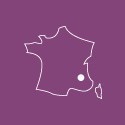
Northern Rhône
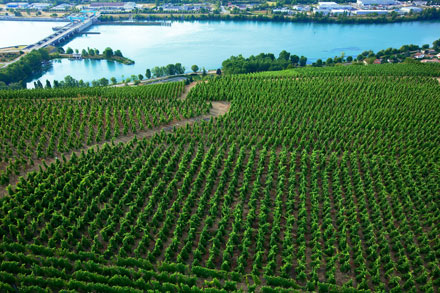
See the latest sales in this region
The Rhône Valley takes its name from the river that winds through the winemaking region over almost 200 km and is made up of two distinct parts: the northern Côtes du Rhône and southern Côtes du Rhône. The grape varieties, winemaking methods, and soil types but also the climates are relatively different. The region is the second biggest producer of AOC wine after the Bordeaux wine region.
The northern Rhône is one of the oldest wine-making regions in France. 65-km long, it stretches from Vienne (in the north) to Valence (in the south). This almost uninterrupted expanse of vineyards covers the appellations of Côte-Rôtie, Condrieu, Château Grillet, Saint-Joseph, Cornas and Saint-Péray. All these appellations are planted in terraces on steep slopes that run down to the river from the west. As for the vineyards of Hermitage and Crozes-Hermitage, they can be found on the east bank.
The climate of the northern Rhône is continental in nature. The summers are hot and very sunny whilst the winters are quite harsh.
The soils are mainly made up of porous granites and shale covered with a fine layer of earth.
Syrah is the only grape variety used for red wines in these northern vineyards, producing dark robed, tannin-rich wines that are generous in body. The majority are excellently suited to ageing. As for the white wines, several grape varieties are grown: viognier, roussanne and marsanne, which are among the rarest and most original whites.
Like most French wines, those of the Rhône Valley bear the name of the place where they come from, but are not subject to a classification system.
The most recent vintages
- 2011: an abundant and heterogeneous harvest producing supple, pleasurable wines.
- 2012: a very good vintage, with palatable wines thanks to their fine freshness and moderate alcohol content.
- 2013: this is another vintage with welcome freshness and lesser alcohol content. These wines are not very tannic and should be enjoyed young whilst still delectable.
- 2014: in the North and in the South, a cool summer and a stormy September have created supple and charming red wines and very drinkable whites thanks to a fine acidity. Limited racking potential.
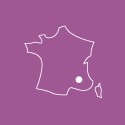
Roussillon
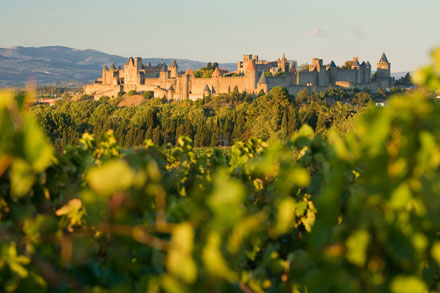
See the latest sales in this region
This region is similar to neighbouring Languedoc in terms of climate, grape type and wines.
Just next door to Spain, Roussillon is full of stony terraces that are ideal for growing natural sweet wines (VDN), which is a particular feature of the vineyards.
There are also black shale, granite and clay-limestone soils.
The climate is a very sunny one, with low, poorly distributed rainfall.
There are 7,300 hectares of vineyards, producing 900,000 hl of wine.
Natural sweet wines (Banyuls, Maury, Rivesaltes) have for a long time been representative of the region’s wines. Today, though, with the modernisation of facilities, the diversification of grape types and new winemaking techniques, there is more production of quality dry wines.
The main grape types are identical to those in Languedoc: for reds, black carignan, syrah, mourvèdre and black grenache. For whites, marsanne, roussanne, vermentino, muscat à petits grains, malvoisie, macabeu, white grenache and grey grenache.
Recent vintages
- 2011: a fine year, with balanced, fragranced reds and dry whites with freshness and acidity.
- 2012: because of the low yields, the reds are complex, deep and voluptuous. The dry whites are fresh and taut. As for the VDN, these are crisp, intense and very balanced.
- 2013: magnificent, very fruity white wines. Reds full of flavour and svelte thanks to the lower alcohol content.
- 2014: a great vintage, fresh and late, charcterised by finesse and freshness. The whites are balanced and very aromatic, while the reds are mature and fine with a great intensity of fruit.
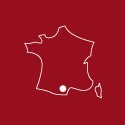
Savoie
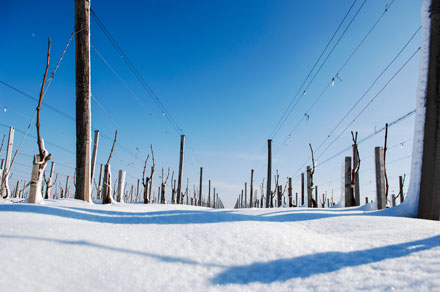
There’s no doubt about it, wines from Savoie evoke memories of winter sports and evenings with friends enjoying a raclette or cheese fondue.
But behind this image hide wines with character, some of which are good for cellaring.
The vineyards are scattered all over the region: through the valleys, on the banks of lakes or on the pre-Alp hillsides. There are 3 Appellations d’Origine Contrôlée (Vin de Savoie, Roussette de Savoie, Seyssel).
The climate is typical of the mountains. It can be harsh, but is also tempered by the water from the lakes and streams.
There are something like 2,200 hectares of vineyards producing around 140,000 hl of wine on average. As is the case in Alsace, the wines are always made from a single grape type.
Whites are in the majority (70%), plus there are reds and a few rosés and sparkling wines.
The main grape types for whites are jacquère (majority),aAltesse, bergeron (called roussanne in Rhone) and chardonnay. They produce fruity wines, sometimes with a little residual sugar.
The red wine grapes are gamay, pinot noir and mondeuse, a typical Savoy type that produces an interesting wine for laying down.
Latest vintages
- 2011: a uniform year, with concentrated, fruity reds with plenty of flavour and with good cellaring potential. The whites are well-balanced and aromatic.
- 2012: a year of low yields. The whites are seductive and refreshing, while the reds are fruity, juicy and easy to drink.
- 2013: varied whites of limited maturity. The reds are very good, featuring fine acidity.
- 2014: a small harvest has given rise to Apremonts and Roussettes of a very high level. In reds, the seductive Mondeuse stands out from the others.

South-West
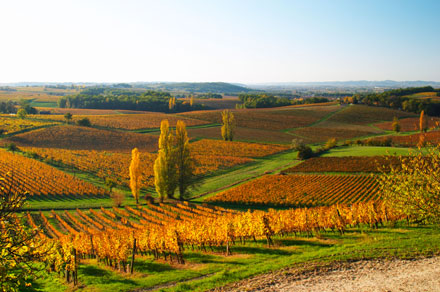
See the latest sales in this region
A very mixed region with a host of small appellations, making it difficult to find a common thread. In fact, the South-West has every style of wine there is, often unusual and offering good value for money.
It is also like an open-air vine museum on account of the many ancient grape types that are only found in this region these days (more than a hundred of them). They all deliver rustic wines with a good dose of the traditional, all the more so as they go remarkably well with the local cuisine, which has gained its own reputation.
There’s no point in looking for any coherence in terms of climate or geology – it would be a waste of time!
Bringing together the many pieces of this giant puzzle, we arrive at a total planted area of around 50,000 hectares and production of approximately 1,600,000 hl.
There are 25 AOC. The best-known include Bergerac, Cahors, Madiran and Jurançon, which produces magnificent dry and sweet whites.
The main grape types used are: for reds, malbec, tannat, fer servadou, négrette and duras. For whites, there are petit manseng, gros manseng, colombard, len de l’el (‘far from the eye’ in the local dialect) and mauzac.
Recent vintages
- 2011: abundant production with high alcohol levels and low acidity. The reds will be ready to drink soon. The whites are full-bodied and expressive.
- 2012: a late, varied vintage. The reds are low in tannin and should be drunk soon. Great dry Jurançons.
- 2013: very successful white wines with plenty of freshness. A more difficult year for reds, although they could reveal some good surprises.
- 2014: paradox of the vintage: whites for racking and reds to be drunk young. The former are sophisticated and dense, while the latter are lighter and fruity. Magnificent sweet wines that combine sugar and acidity.

